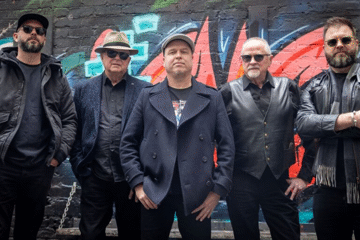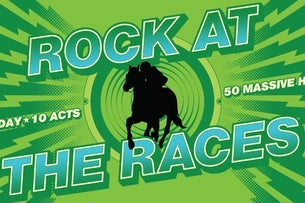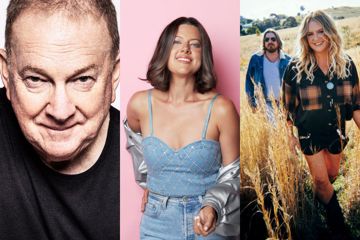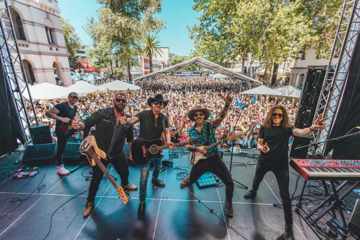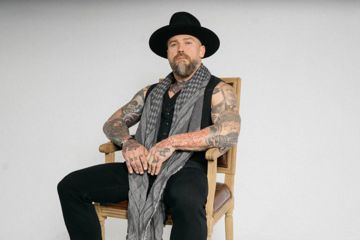When Ten Rock Heroes Met Their Own Heroes… Or Came Close To It
Have you ever wondered what happened when your favourite rock star met their hero? Here are ten stories.

Angus Young, Tash Sultana, Flea (Credit: Jared Leibowitz, Giulia McGauran + These Wild Eyes, Stephen Booth)

An eye to the soul of the complete works of our rock heroes is to see who their heroes were, and how they showed them the path in the first place.
Here are ten examples.
BRUCE SPRINGSTEEN
Growing up in New Jersey, Bruce Springsteen idolised Frank Sinatra, Hank Williams, Woody Guthrie and Bob Dylan.
He said, “These were all people who brought their entire philosophy along with them, created a world that would engulf you… Assist you in different ways of living, different ways of presenting yourself.”
But most epic for the Boss was Elvis Presley, of whom he said, “There is only one king.”
Join our community with our FREE weekly newsletter
Like for many in his generation, listening to his 1956 hit Hound Dog as a seven-year-old “just shot straight through to my brain. I realised, suddenly, that there was more to life than what I'd been living.”
At 21, he and his best friend Stevie Van Zandt went to see him perform in Philadelphia (May 28, 1977). It was, Bruce would admit ruefully, “not a good night.”
That night, he went home and wrote Fire for Elvis to sing. A demo was sent to the King’s office.
But Elvis died three months later (August 16) in his Memphis mansion, Graceland.
So he later gave the song to rockabilly guitarist Robert Gordon (playing piano on that version), although it was a hit for The Pointer Sisters.
Tragically
When he heard of Presley’s death, Springsteen remarked, “It was so hard to understand how somebody whose music came in and took away so many people’s loneliness and gave so many people a reason and a sense of the possibilities of living could have, in the end, died so tragically.”
He wrote the song Johnny Bye Bye with lines such as, “They found him slumped up against the drain/ With a whole lotta trouble running through his veins/ Bye bye Johnny/ Johnny bye bye/ You didn’t have to die/ You didn’t have to die.”
After his death, Bruce would recall at concerts and TV appearances of the time that he and Van Zandt, after an E-Street Band show in Memphis, tried to find an all-night diner.
At 3 am, they hailed a taxi driver who suggested, “Yeah, there’s one right out by Elvis’s house.” To which Springsteen responded, “Elvis’ house?! You know where Elvis lives? Take us there, right now.”
They were deposited at 764 Elvis Presley Boulevard, aka Graceland. Bruce saw lights on the second floor and figured Elvis was still up reading.
The heavy gates were locked. Looking at the stone wall, he told his guitarist, “Steve, man, I gotta go check it out.” The cab driver warned, “They got big dogs over there. Don’t go over that wall.”
Figuring he’d never get the chance again, Springsteen jumped the wall and ran up to the front door.
He was about to knock when a security guard emerged from the bushes, “Can I help you?”
As casually as he could, the rocker said, “Yes, is Elvis here?” to be told, “Elvis is in Las Vegas.” (another version says Elvis was in Lake Tahoe).
At the time, Springsteen was just starting to break into the mainstream with Born To Run, so he told the guard, “Okay, well, can you tell [Elvis] … that Bruce Springsteen was here. And he may not know who that is, but I was just on the cover of Time and Newsweek.”
The guard said he would let his boss know, took his arm and walked him down to the gates to let him out and rejoin Van Zandt.
“That’s as close as I ever got to Elvis Presley.”
FLEA
The Melbourne-born Red Hot Chili Peppers bassist worshipped Nigerian drummer and composer Tony Allen, who was renowned for his inventive drum patterns. He was since 1964 a cohort of African drummer and band leader Fela Kuti, these days hailed as the godfather of Afrobeat.
Calling Allen “one of the greatest drummers to ever walk this Earth,” Flea went on to exclaim, “What a wildman, with a massive, kind and free heart and the deepest one-of-a-kind groove.
“Fela Kuti did not invent Afrobeat; Fela and Tony birthed it together. Without Tony Allen, there is NO Afrobeat.”
Allen and Flea formed the band Rocket Juice & The Moon in 2008 with Blur’s Damon Albarn, releasing their self-titled album four years later.
“I was lucky enough to spend many an hour with him, holed up in a London studio, jamming the days away. It was fucking heavenly. He was and still is my hero.
“I wanted to honour his greatness so much when we played together, and I was nervous when we started, but he made me laugh like a two-year-old, and we fell right into pocket.”
ANGUS YOUNG
The Young home in Sydney was filled with ‘50s rock and roll, including Chuck Berry, Little Richard and Jerry Lee Lewis. But one stood out in the race. “Chuck’s chops were bigger than the songs. He was the first with a guitar signature.”
But it was when Angus Young saw Chuck in concert – on April 3, 1975, at the Hordern Pavilion in Sydney – that he was shaped, from the duckwalk, the onstage patter, the wink-wink lyrics and commitment to electrifying shows.
"I just loved his stage presence and how he performed,” Angus said. He was one of those people; when he got on a stage, he owned it."
The two did meet in the ‘70s, but Chuck was in one of his moods, and Angus left the meet-up thinking he was unfriendly.
But it left no bitter taste. On British radio in 2021, Angus was full of praise: "Chuck Berry was probably one of the great guitar people for rock and roll. He combined a lot of elements — he combined blues, a bit of jazz and his own unique style.
“He melded all these kinds of different genres of music, but he seemed to bring it together and bring it out, and it came out in that rock and roll style — so plain and simple, but it was so effective.”
JONI MITCHELL
Emerging from the folk clubs of Canada in the ‘60s, Joni Mitchell was unique for her unconventional and personal songs, her strong vision of what she wanted to achieve in the studio, and the way she incorporated pop, jazz and rock.
Even her guitar playing is different, because “I hear it as an orchestra: the top three strings being horn section, the bottom three being cello, viola, and bass—the bass being indicated but not rooted.”
But even she, along with most of her contemporaries, fell under the influence of Bob Dylan and the way he gave her a vision for her work.
“I wrote poetry and I painted all my life,” she explained. “I always wanted to play music and dabbled with it, but I never thought of putting them all together. It never occurred to me.
“It wasn’t until Dylan began to write poetic songs that it occurred to me you could actually sing those poems.”
They met in Nashville in 1969, when both appeared on The Johnny Cash Show, which was taped on May 1 at Ryman Auditorium, a renovated church-turned-TV studio, and went on air in the US on June 7.
Mitchell was calm and cool, Dylan was uncomfortable on TV and made more wired due to technical glitches during taping. But he adored Johnny Cash – they met in 1964 at a folk festival and the older man gave the young one a guitar – and would do anything for him.
Cash, in the meantime, made sure that Dylan was as comfortable as possible and kept the media away.
The TV appearance was iconic. But as Cash recounted on a 1985 appearance on The David Letterman Show: "That night in my house [was] the first time these songs were heard...
“Joni Mitchell sang Both Sides Now, Graham Nash sang Marrakesh Express, Shel Silverstein sang A Boy Named Sue, Bob Dylan sang Lay Lady Lay, and Kris Kristofferson sang Me & Bobby McGee. That was the first time any of those songs were heard."
Dylan and Mitchell remained close after this Nashville encounter.
KEITH RICHARDS
Keith Richards said: “When I started, all I wanted to do was play like Chuck [Berry]. I thought if I could do that, I’d be the happiest man in the world”.
But the intense respect for the American music pioneer intensified when, as a teenager, he saw Berry in July 1958 at Jazz On A Summer’s Day.
The players were brilliant jazz musicians, but they were snooty about anyone who played rock and roll.
Richards told Rolling Stone: “With Sweet Little Sixteen, Chuck took them all by storm and played against their animosity. To me, that’s blues. That’s the attitude and the guts it takes.
“That’s what I wanted to be, except I was white … I listened to every lick he played and picked it up.
“Chuck got it from T-Bone Walker, and I got it from Chuck, Muddy Waters, Elmore James and B.B. King. We’re all part of this family that goes back thousands of years. Really, we’re all passing it on.”
Richards rated Berry so highly in this process that he dismissed some of the run-ins he had with him.
At Berry’s 60th birthday shows at the 4,500-seat Fox Theatre in St. Louis, Richards was playing with Eric Clapton, Linda Ronstadt, Julian Lennon, Etta James, Robert Cray and Berry’s longtime pianist Johnny Johnson.
The shows were being filmed for Taylor Hackford’s documentary Hail, Hail Rock ‘n’ Roll. There was tension and delays, and suddenly Berry started shouting at Richards.
Chuck had been OK with Keith taking lead lines when others were singing Chuck’s songs. But he wanted centre stage when he was singing. “You’re gonna have to let me lead on the songs I sing,” he snapped. “I’m responsible for how they go over.”
Keith put down his guitar and left the stage until the song in dispute was finished.
In another instance, in New York, Keith went backstage and, spying Chuck’s guitar in its case, took it out and started to play it. An enraged Chuck, seeing this when he entered the room, punched the Rolling Stone in the eye. “It was his biggest hit,” Keith laughed.
JIMI HENDRIX
“The first guitarist I was aware of was Muddy Waters,” Jimi Hendrix revealed in 1968. I heard one of his old records when I was a little boy. It scared me to death because I heard all of those sounds. Wow, what is that all about? It was great.”
Hailed as “father of the Delta blues” and “King of Chicago electric blues”, Waters changed the sound of the guitar after World War II, the way Jimi did 20 years later.
Hendrix, who started playing guitar at the age of six or seven, went on to find records by Elmore James and Robert Johnson.
But growing up in Seattle, in the American northwest, he didn’t get to see any blues players live until he moved south in his late teens, joining the Army in the 101st Airborne Division and stationed at Fort Campbell, Kentucky.
During his all-too-brief music career, Hendrix often spoke of his love for Muddy, how he warmed up before his shows to his music, about the older man’s role in helping to invent psychedelic rock on his Electric Mud album, and his desire to one day play with him.
The latter never happened, but he managed that (sort of) by playing Muddy’s Mannish Boy and acknowledging how I’m Your Hoochie Choochie Man was a blueprint for his own blues workouts.
He took what British guitar heroes of the time, including Clapton and Page, were hearing, but took it to a whole new stratosphere with dazzling vision and technique.
TASH SULTANA
Tash Sultana, who heads back to the US again this month, is renowned for playing 23 instruments. But they had been playing guitar for ten years before they experimented with the other sounds, and started loop-pedal busking around Melbourne.
Their list of guitar inspirations included Lindsay Buckingham, John Butler, Jimi Hendrix, Carlos Santana, AC/DC, Jimmy Page and Brian May.
One stand-out was John Mayer, about whom they once said, “He has an expressive, less-is-more relaxed technicality to his playing. It’s tidy and clean with a good sense of feel, timing and playing behind the beat.”
They cited his approach to soloing and switched from Teles to Strats (the yellow Daphne and the 1962 blue Vinnie, for which they paid so much that Nile Rodgers was shocked) after hearing his performance on Slow Dancing In A Burning Room.
They told one magazine: “I really like that song of his, because it's all about the pace. It's just about being slow and saying enough with taking all of the expression really really slowly.
“I love everything about achieving the cleanest tone possible. He's just a fantastic guitarist that I aspire to be like.”
The change in their sound and the way they played guitar was so exhilarating that they have challenged Mayer to a duel jam.
“BUT now it’s time buddy @johnmayer you’ve been sleeping on a good jam. TAG THIS BLOKE, let’s make it happen.”
They got their fans to also put the pressure on Mayer to agree.
Nearly 1,500 of them had thumbed up the idea 17 hours after first making the challenge on social media.
Sultana sells out shows abroad, moved 100,000 tickets on an Australian tour, and tracks from their debut album Flow State clicked over one billion worldwide streams.
JOHN BREWSTER
Before forming The Angels, John and Rick Brewster entered the spotlight in fairly unorthodox ways for future rock guitar heroes.
Their father was a principal cellist for the Adelaide Symphony Orchestra and later director of music for the ABC, their grandfather a concert pianist and conductor, and their grandmother sang opera.
Rick studied classical piano, won the Eisteddfod in South Australia at age 16, and was heading towards a career in classical music.
John laughs, “I was the black sheep of the family” for getting besotted over Bob Dylan and Chuck Berry.
This mixture was a reason why The Angels were massive in Europe, toured the US numerous times, and counted on David Bowie, Kurt Cobain, Pearl Jam and Elton John among their fans.
At one Adelaide Fringe, Brewster did solo acoustic shows devoted to Dylan songs, recalling how he blew his mind when he toured Australia in the 1960s.
With Berry, he took it one step further: he played bass in his backing band during a tour. “It was nice to be onstage with him, but he insisted I could not play bass runs, which was dull, and he was definitely hard work!”
JIMMY PAGE
Jimmy Page was a 14-year-old struggling to learn the guitar when he heard Link Wray’s classic instrumental Rumble on a jukebox and went, “What the…?”
In 2023, when the Led Zeppelin legend inducted Wray at the 38th annual Rock & Roll Hall of Fame ceremony in New York, he recalled why that single blew his mind.
“The Vigour in it. The Strength in it. The Power in it. There was something else. It was fearless. It was just phenomenal. It’s the essence of cool. It’s just a masterpiece that just sort of melted its way into the fibres of my body and my consciousness, as far as the drama that you can set up with six strings.
“It’s the sort of stuff that can’t be taught. It’s the sort of stuff that you feel and you can take it on board if you like it.”
Fred Lincoln “Link” Wray, Jr., was born in 1929 in North Carolina. Of Shawnee heritage, his family suffered racial discrimination due to their Native American background.
Wray fought back with tracks like Comanche, Apache and Shawnee.
He died in November 2005, but his name keeps cropping up on Best Guitarists lists and his music continued to be used in movies and TV shows such as Pulp Fiction, Confessions Of A Dangerous Mind, Blow, Desperado, Independence Day, The Fabelmans, Poker Face, Father Stu and Reservation Dogs.
DAVID GILMOUR
There’s only a year’s difference between Pete Townshend of The Who and David Gilmour, who from 1967 created the iconic guitar-scapes for Pink Floyd’s Dark Side Of The Moon and Wish You Were Here.
But one regards the other as “my hero”. David told French Guitarist magazine in 2002, “When I was very young, I hitchhiked from Cambridge to London to see him play at the Marquee Club.
“It was the very beginnings of The Who. He is incredible. He rarely plays lead, well, he could very well do…”
The two became close friends and played concerts together in the 1980s. This was when Townshend was on a solo career and suffering from hearing problems.
Doctors told him to play acoustic only, so Gilmour was asked to play electric guitar. “He couldn’t play the loud parts, and he gave them to me.
“He is doing much better today, and he went back to electric without problem.
“So much the better! I can’t imagine Pete without being able to do the mill on his guitar!”
Related Gigs

